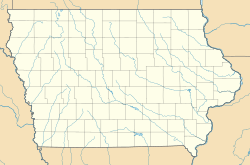St. Mary's Academy (Davenport, Iowa) facts for kids
Quick facts for kids |
|
|
St. Mary's Academy
|
|
 |
|
| Location | 1334 W. 8th St. Davenport, Iowa |
|---|---|
| Area | 2 acres (0.81 ha) |
| Built | 1888 |
| Architectural style | Romanesque |
| MPS | Davenport MRA |
| NRHP reference No. | 84001556 |
| Added to NRHP | July 27, 1984 |
St. Mary's Academy is a historic building found in Davenport, Iowa. It is located in a residential area on the west side of the city. This building was once a school for St. Mary's Catholic Church. The church itself is also a historic site. St. Mary's Academy was officially added to the National Register of Historic Places in 1984.
Building History
This building was constructed in the late 1800s. It was built when Father Michael Flavin was in charge of the church, from 1871 to 1884.
Later, the church built a new school and a place for nuns (a convent) right across the street. After this, the original St. Mary's Academy building found a new purpose. It became a home for older women and young women who worked in the city. The Sisters of Mercy, a group of nuns, helped run this home. During this time, a small chapel was added to the back of the building. People then called the building St. Mary's Home. Much later, the building was changed again and divided into apartments.
Building Design
St. Mary's Academy is built with red brick. Its style is called Romanesque Revival. This style often uses round arches and strong, heavy shapes.
You can see bands of rough stone above the windows. The main entrance also has this same type of stonework around it. The building has 3½ stories and a rectangular shape. It has a hipped roof, which slopes down on all sides. The corners and ends of the building stick out a bit, and they have special walls called parapet gables that rise above the roofline.
The front of the building looks the same on both sides, which is called symmetrical. There is fancy brickwork along the top of the building, just under the roof. The main entrance is made of cast iron and features beautiful art glass. It also has decorative patterns called Greek frets. A statue of the Blessed Virgin Mary can still be seen in a special spot above the entrance.



